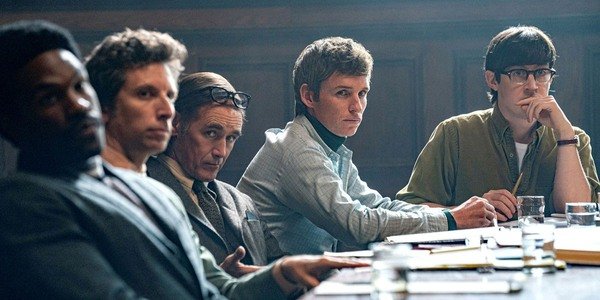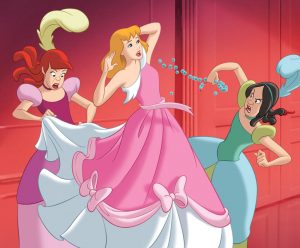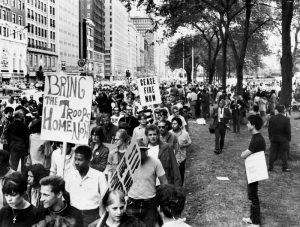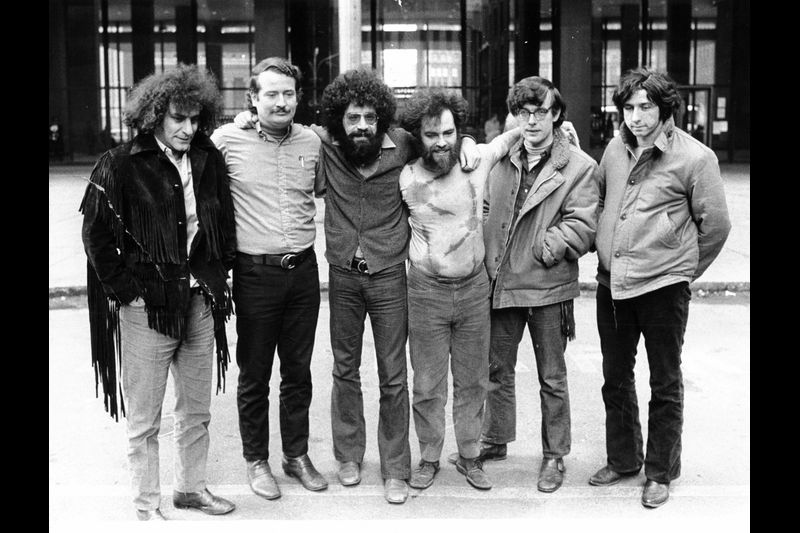
Why Care if They Made it Up? Historical Accuracy in The Trial of the Chicago 7
At the climax of The Trial of the Chicago 7, Tom Hayden uses his closing remarks to read out the names of Americans killed in the Vietnam War. One by one the defendants stand and raise their fists in solidarity. Music swells as the gallery stands. Eventually Richard Schultz, the prosecutor, sheds a tear and rises as well. “What are you doing?” asks his co-prosecutor, to which Schultz answers “paying respects.” It’s a powerful, well-constructed scene with a very significant problem: it never happened.

Why should this bother us? After all, movies of historical events are full of things that didn’t happen. Conversations are invented, thoughts speculated, and perspectives manufactured. Very little of the dialogue spoken in Chicago 7 was actually uttered by the historical figures portrayed on film, so why would some scenes and not others stand out as particularly wrong? To put it another way, what is it that makes us care about the historical accuracy of some scenes more than others?
The natural place to start is the idea that some fictionalized scenes make the movie worse, but others do not. We don’t care about the smaller inventions because they don’t substantially affect how the movie goes, they’re more like the little cogs that keep the rest of the movie ticking. Inaccuracies in the big showpiece scenes, on the other hand, are the real substance of the movie. If the big scenes are bad, that’s much more significant in making the whole film bad, so it’s the big scenes that we care about.
Now, we have to be careful about not falling prey to a circularity here. What I’ve just written could be interpreted as saying that we care about the big scenes because they determine the goodness or badness of the movie, and those scenes determine the goodness or badness of the movie because we care about them. To dodge this problem, I need to offer an additional way to think about the big scenes being good or bad. For this I want to reach for aesthetic cognitivism.
Aesthetic cognitivism has two components. The first is the idea that works of art can have cognitive content. This means that art can be a source of understanding about the world, and provides us the sort of content which is the basis of understanding. The second part of aesthetic cognitivism is that works of art can be better or worse as works of art based on their cognitive content.

A common type of cognitive content is what’s called a “cognitive-affective perspective.” This means that a film does not just present the viewer with a bare set of facts, but it presents an emotionally-laden way of viewing a subject justified by certain information. In the case of Cinderella, for example, we are invited to feel sympathetic towards the titular Cinderella, and that sympathy is justified by the suffering inflicted upon her by her wicked stepmother and stepsisters.
This starts to help us understand why we care about some scenes in a movie but not others. The small scenes, the cogs that just keep the film moving, don’t necessarily provide cognitive-affective perspectives on the important historical events. And to the extent that they do contribute to such perspectives on the characters, their contributions are minor: hallway dialogue developing characters or a moment alone to show how a character is feeling. On the other hand, significant scenes like the climactic honouring of the dead in Chicago 7, play a very significant role in determining the cognitive-affective perspective a film offers of its subjects.
What is the perspective offered by that courtroom scene? First of all, it shows the protagonists as righteous. Specifically, they’re righteous because of a commitment to a set of higher values of justice and unity centred on a patriotic belief in the value of America. This unity is endorsed by (and therefore the righteousness is extended to) not just the defendants and observers, but also the prosecutor.
It’s a powerful, well-constructed scene with a very significant problem: it never happened.
The patriotic commitment of the scene is the culmination of the film’s narrative which emphasizes the patriotic commitment of the characters: Abbie Hoffman talks on the stand about the greatness of American institutions, Jerry Rubin defends a flag-waving protester from a sexual assault by a bunch of frat bros, and the reveal of Tom Hayden’s radical commitment begins with defending a teenager ascending a flagpole. Bobby Seale, leader of the Black Panther Party, is granted a mistrial after his treatment by the judge is so egregious that the prosecutor Schultz is moved to outrage. Altogether, then, the film offers a vision of the defendants, especially Hoffman and Hayden, as true patriots who believe in the strength and virtue of the American ideal. Their patriotism is so strong that the abuses of the court move everyone to outrage, and that outrage becomes a source of patriotic unity. This culminates in the film combining the symbols of a defiant raising of the fist with standing to mourn America’s war dead.
So what’s the problem?
Cognitivism holds that art can be a source of understanding. To offer proper understanding of something, what the film offers about that thing must be true. The patriotic narrative is not true. In fact, it is strikingly false. While Hayden did record America’s war dead in his notebook, he did not record only America’s war dead. He recorded all the war dead, especially those of the Vietnamese. His opposition to the war was not rooted in an American patriotism, but rather an opposition to war as an imperial project. Hayden saw this imperial project as fundamental to the United States, and so opposing the war meant opposing the entirety of the American state structure. The movie inverts the entire moral mission of the defendants. They are not patriots driven to outrage by the corruption of American virtues, as the film presents, but universally-minded political activists driven by an opposition to inextricable American vices.[1]

And what of the message of unity? The prosecutor Schultz, it turns out, felt no such sympathy for the defendants. In fact, interviews conducted with Schultz leading up to the release of the film show that he’s still convinced of the righteousness of the trial, and the criminality of the defence.[2] In light of Schultz’s lasting commitment to the righteousness of the prosecution, the film’s presented unity between him and the defendants seems particularly misplaced.
Altogether, then, the film presents a cognitive-affective perspective that seems to get important facts wrong. It therefore presents an incorrect understanding of historical events, which undermines its cognitive value. To this we might add that since The Trial of the Chicago 7 is specifically of a genre that cares about accurately depicting historical events, this cognitive disvalue is particularly significant. If the movie is bad at one of the things it is specifically supposed to be good at, then that seems significant.
However, there’s still something missing. When the film misrepresents the moral mission of the defendants, it seems to be doing something not just factually wrong, but morally wrong. The issue is not just that the movie is worse as a movie, but rather that it (or the filmmakers) have committed some more serious moral offence. I believe this can be addressed by appealing again to cognitive-affective perspectives. Specifically, we can say that the cognitive-affective perspectives the film provides are not merely inaccurate to historical events, they’re morally inaccurate too.
So what’s the problem?
Chicago 7’s moral inaccuracy is grounded in its historical inaccuracy. This is to say that the perspective the film offers is wrong in such a way that the factual wrongness is itself morally bad. Some of this is part of a disrespect for the historical characters. Hayden, Hoffman, Seale, and the rest of the defendants ended up on trial for acting on political convictions which were deeply important to them. Misrepresenting their important personal convictions consequently fails to respect how their actions followed from their values. This insult is heightened by the film inverting their values, turning them in to dedicated patriots.
There is also a deeper moral wrong. The film presents a cognitive-affective perspective not just on the characters but on a deeper set of values. The film presents a moralized view of the world which centres the value of American institutions, American lives, and American patriotism. The greatest sins in the world of Chicago 7 are not of the mass murder that Hoffman, Hayden and Seale actually opposed but rather disunity and procedural impropriety. In showing Hayden and Hoffman as patriots and Schultz as sympathetic, the historical inaccuracy of the movie turns in to moral offence, not just promoting questionable moral values but doing so at the expense of a more penetrating and urgent moral criticism.

This, then, gives us our twofold answer to the question of why we care about the historical inaccuracy in The Trial of the Chicago 7. The film does not just relay to us a set of historical facts, but also presents an emotionally-laden perspective on those facts. The inaccuracy of the facts, and the inaptitude of the perspective, undercuts the film’s cognitive value: by presenting a false vision of past motivations the film thereby presents an incorrect understanding of historical events. This inaccuracy is morally loaded, as it promotes not just an inaccurate factual understanding but also a bad set of moral values. This helps explain both why we might think historical inaccuracy makes a film worse and also why historical inaccuracy is a moral offence that extends beyond questions of a film’s value.
Footnotes
[1] Jeet Heer, Aaron Sorkin sanitizes the Chicago 7, Nation, October 21, 2020. "https://www.thenation.com/article/culture/chicago-7-trial-film/"
[2] Jason Meisner, Chicago 7 Prosecutor: ‘They were going to try and destroy our trial. And they did a damn good job.’, Chicago Tribute, October 28, 2020. https://www.chicagotribune.com/news/criminal-justice/ct-chicago-7-prosecutor-dick-schultz-seminar-20201020-xlabkrtwrfgk3mezgraswhqkxq-story.html
Further Reading
If you wish to delve further, see chapters 7 and 8 of Berys Gaut's Art, Emotion and Ethics, Oxford University Press (2007).
If you want to explore other aspects of philosophy of film, you might start with the Stanford Encyclopedia of Philosphy entry on Philosophy of Film.
No comments
Start the conversation…